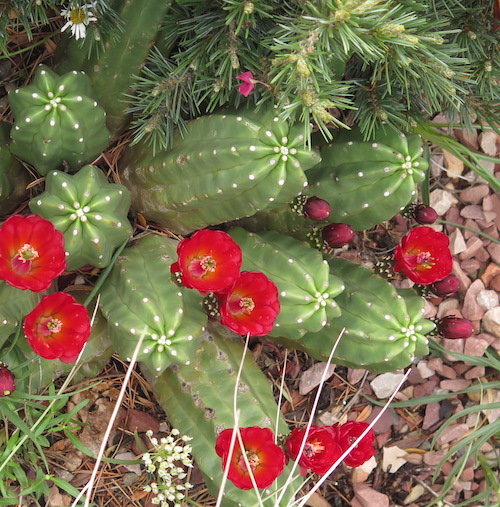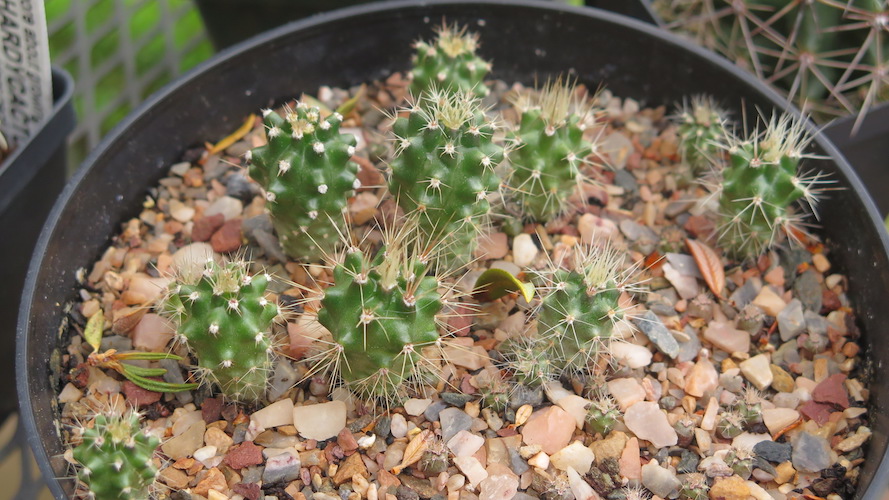Every garden I’ve visited has taught me something new. Be it a tropical conservatory that reveals an exotic plant I’d never before seen, or a hard-working greenhouse that tutors me in a growing technique to raise better plants, it all makes for a smarter garden and gardener.

For example, at Hunting Brook garden in Ireland, Jimi Blake has studded cacti among tender succulents and colorful perennials; the cacti’s columnar form adds texture (and humor) to the mix. It’s an attention-grabbing combo for sure, and given the dependably moist Irish climate and bone-aching winter cold, one that takes some work to sustain. I considered how my own patch in the Rockies could benefit from some of these spiny wonders: we may not have the daily rainfall that Irish gardens enjoy, but we do have cold for a good part of the year.

Cue Pat and Joel Hayward and their garden in the hogbacks of the northern Rockies outside Loveland, Colorado. Pat is the former executive director of Plant Select, and a mine of information about what we can and should grow in our region; Joel is a talented composer, musician and an expert grower of succulents and cacti as demonstrated by the specimens in the beds and in pots positioned around the garden that punctuate the gentle tapestry of sub-alpine and native plants Pat cultivates. In early summer, when colors tend to soft mauve, blue and buttery yellows, the orange-scarlet bunches of goblet-shaped blooms bursting from the clumps of cacti really pop. And best of all, these sparklers are winter hardy, easy to grow from seed and generally well suited to gardens in the southwest.

Choosing among so many in their garden, Echinocereus triglochidiatus stood out as a good starter plant: it’s a large group to pick from, thanks to the many subspecies and local variants that can be found across Zones 5-10; many are orange flowered, but ‘White Sands’ is a dependable cold-hardy sort, and garden-friendly. Commonly called the Claret Cup cactus for its vivid red blossoms, the thick stems can grow to two feet tall and a mature plant raised from seed will often make a hearty clump in as little as seven years. Joel Hayward has found that seed from his original ‘White Sands’ plant germinates quickly, but has noticed that the seedlings often vary widely from their parent. This has given rise to a plant-nerdish joke: ‘White Sands’ was collected and introduced by cactus specialist Steven Brack, and takes its name from the White Sands area near Alamogordo in south-central New Mexico, where Brack found the plant; Trinity, the first hydrogen bomb test, took place nearby, so looking at the diversity of this single plant, one has to wonder, was it always so, or did nuclear fission play a role in producing this unusual strain? Stranger things have happened.

Joel describes his seed-growing technique, and it’s as simple as it gets: “Collect and clean seed when the fruit is ripe. I like to sow immediately but seed can be stored if properly dried. Provide bright light and humidity for germination, either by tenting individual pots or housing in humid location. Maintain humidity for first 7 to 10 days after germination (avoid condensation dripping on seedlings) and then transition to normal conditions. Avoid placing seedlings in full sun until they have developed some spines for sun protection. Do not let seedlings dry out completely, but do not over water. [nb. Use a loose, free-draining potting mix, and dust clean sand or vermiculite over the surface. I use Ziploc bags as mini- greenhouses; in that way I can ‘vent’ the seedlings as they grow by simply zipping the bags open.]
The first true cactus garden I ever saw was in a suburb south of San Antonio, Texas, and was just that–cacti and more cactus. The effect was unrelenting and the living definition of what is known as “a pincushion garden.” Introducing succulents can soften the effect, but the best antidote is to blend cacti with perennials and annual natives, as they would be in their natural habitat. Joel advises choosing companion plants that are slow growing and won’t crowd the cacti and also helps because, as he remarks, “regular garden maintenance tasks around the cacti present their own set of challenges.” Note to self: acquire a pair of sturdy gauntlets for dead heading and weeding.

When moving plantlets into their new homes, gently remove all soil from the young root ball, plant firmly but do not water them in, keep them dry for several days so that roots callus over and toughen up. If wet weather threatens, cover the plants with an overturned flowerpot to keep the plants dry, but ventilated. Water is not the cacti’s friend, but full sun, and lean, well-drained soil are. Use sharp gravel to mulch around the base. It will assist drainage, and not add organic matter to the soil, as plant-based mulch would do as it decomposes.
Watch this space to see where I go next—maybe we’ll learn something new.
© Text and photos, Ethne Clarke, 2019
For information about Jimi Blake and Hunting Brook Garden visit his website at http://www.huntingbrook.com/ and to pre-order Jimi’s book, due out from Filbert Press UK in September, go to https://amzn.to/2YgHKVS
Mesa Gardens, New Mexico is home to Steven Brack and his cacti nursery; to purchase seed, go to https://mesagarden.com/
Plant Select’s info-packed website is found at https://plantselect.org/


